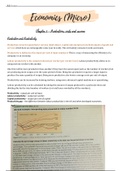1|Page
–
Production converts inputs/factor services (land, labour, capital and enterprise) into final outputs of goods and
services which have an exchangeable value (can be sold). This will satisfy consumer needs and wants.
Productivity is defined as the output per unit of input employed. This is a way of measuring the efficiency of a
company or an economy.
Labour productivity is the output produced per worker (per worker-hour). Labour productivity allows us to
compared one worker with another.
One firm will be more productive than another if they have the same input (such as the number of workers) but
are producing more output, over the same period of time. Being less productive requires a larger input to
produce the same quantity of output. Being more productive also lowers average costs per unit of output.
Productivity can be increased by training workers, using more advanced capital machinery or specialising.
Labour productivity can be calculated by taking the amount of output produced in a particular time and
dividing this by the total number of workers (or total hours worked by all the workers).
Productivity – output per unit of input.
Labour productivity – output per worker.
Capital productivity – output per unit of capital.
Productivity gap – the difference between labour productivity in the UK and other developed economies.
, 2|Page
The division of labour is a type of specialisation where production is split into different tasks and specific
people are allocated to each task (for example, making a chair, some can specialise in making the legs while
other may specialise making the seat). Adam Smith explained the increase in productivity and output could be
achieved through the division of labour. By specialising, firms can then take the advantage of increased
efficiency and lower average costs of production.
Advantages of Specialisation Disadvantages of Specialisation
Time is saved as a work specialising in a task will not Workers do repetitive tasks, which can lead to
have to keep on switching between tasks boredom affecting quality and labour productivity.
More and better machinery/capital can be employed Structural unemployment as skills may not be
transferable, especially if the workers have focused
on one task
‘Practice makes perfect’ – workers become more By producing and specialising one type of good,
efficient/productive at the task they are doing, the variety could decrease for consumers
greater the time spent
This can lead to better quality and a higher quantity Lack of flexibility, companies may move elsewhere,
of products for the same amount of effort overall the workforce left behind can struggle to adapt.
(increased labour productivity)
Firms can achieve economies of scale (production Countries becoming less self-sufficient could be
line, where each person produces one or two tasks) problematic if trade is disrupted. Let’s say a country
specialises in manufacturing and imports its oil. If it
falls out with the oil supplier, the country may be in
trouble
Training costs reduced if workers are only trained to
perform certain limited tasks
More efficient production, tackling scarcity as
resources are used more efficiently, with more
output can be produced per unit of input
If countries were to specialise, trade becomes vital, for countries to be able to obtain the things they’re no
longer making for themselves. It is then necessary to have a way of exchanging goods and services between
countries. Before, the method for exchange was by bartering; however, this requires a ‘double coincidence of
wants’ (both parties have to want the good the other party offers). This is inefficient as it requires a lot of time
and effort. By using money as a medium for exchange is the most efficient way of exchanging goods and
services, as it is something both buyers and sellers value, even if the sellers don’t want the things the buying
country produces. Money provides:
➔ A measure of value: The value given to a good can be measured in US dollars. Jewellery considered
more valuable than a table due to its relative price, measured by money.
➔ A store of value: Money has to hold its value to be used for payments. It can be kept for a long time
without expiring.
➔ A method of deferred payment: Money can be paid at a later date for something that’s consumed now
(UNI fee’).
➔ Trade – the buying and selling of goods and services.
➔ Exchange – to give something in return for something else received. Money is a medium of exchange.
➔ Specialisation – a worker only performing one task or a narrow range of tasks. Also, different firms
specialising in producing different goods or services.
➔ Division of labour – this concept goes ‘hand in hand’ with specialisation. Different workers perform different
tasks in the course of producing a good or service.





